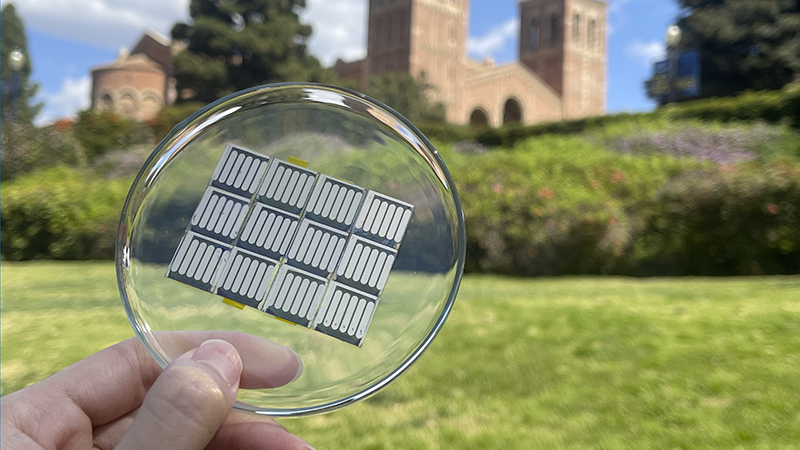Perovskite solar cells exhibit great potential for enhanced energy-conversion efficiency; however, they degrade in sunlight, causing their performance to deteriorate over time. Materials scientists at the University of California, Los Angeles (UCLA) Samueli School of Engineering and colleagues from five other international universities have discovered the main reason behind this degradation.
 Photo of a thin film perovskite solar cell produced with a manufacturing process fix developed by UCLA researchers and colleagues. Image Credit: Shaun Tan/UCLA
Photo of a thin film perovskite solar cell produced with a manufacturing process fix developed by UCLA researchers and colleagues. Image Credit: Shaun Tan/UCLA
The team successfully showed a basic manufacturing modification to repair the reason for the degradation, thereby clearing the biggest obstacle toward the extensive acceptance of the thin-film solar cell technology.
A research paper illustrating the discoveries was published recently in the journal Nature. The research is headed by Yang Yang, a UCLA Samueli professor of materials science and engineering and holder of the Carol and Lawrence E. Tannas, Jr., Endowed Chair. The co-first authors are Shaun Tan and Tianyi Huang, both recent UCLA Samueli Ph.D. graduates whom Yang mentored.
Perovskites are a class of materials that possess identical crystal structure or atomic arrangement as the mineral calcium titanium oxide. Metal halide perovskites, a subgroup of perovskites, are of immense research interest due to their favorable application for energy-saving, thin-film solar cells.
Perovskite-based solar cells could be manufactured at a much lower cost compared to their silicon-based equivalents, rendering solar power technologies more accessible if the universally known degradation due to prolonged exposure to sunlight can be effectively resolved.
Perovskite-based solar cells tend to deteriorate in sunlight much faster than their silicon counterparts, so their effectiveness in converting sunlight to electricity drops over the long term. However, our research shows why this happens and provides a simple fix. This represents a major breakthrough in bringing perovskite technology to commercialization and widespread adoption.
Yang Yang, Study Lead and Professor of Materials Science and Engineering, Samueli School of Engineering, UCLA
Yang is also a member of the California NanoSystems Institute at UCLA.
A standard surface treatment used to eliminate solar cell imperfections involves placing a layer of organic ions that renders the surface very negatively charged. The researchers learned that while the treatment is meant to enhance energy-conversion efficiency during the production process of perovskite solar cells, it also inadvertently forms a more electron-abundant surface — a potential trap for energy-containing electrons.
This condition weakens the organized arrangement of atoms, and in due course, the perovskite solar cells become progressively less efficient, eventually making them unappealing for commercialization.
Equipped with this new finding, the team discovered a method to resolve the cells’ long-standing degradation by coupling the positively charged ions with negatively charged ions for surface treatments. The switch allows the surface to be more stable and electron-neutral while maintaining the reliability of the flaw-prevention surface treatments.
The researchers tested the strength of their solar cells in a laboratory under enhanced aging conditions and 24/7 lighting designed to imitate sunlight. The cells succeeded in retaining 87% of their original sunlight-to-energy conversion performance for over 2,000 hours.
To understand the difference, solar cells produced without the remedy declined to 65% of their primary performance after testing over the same period and settings.
Our perovskite solar cells are among the most stable in efficiency reported to date. At the same time, we’ve also laid new foundational knowledge, on which the community can further develop and refine our versatile technique to design even more stable perovskite solar cells.
Shaun Tan, Study Co-First Author and PhD Graduate, Samueli School of Engineering, UCLA
The study’s other corresponding authors are Rui Wang, an assistant professor of engineering at Westlake University in Hangzhou, China; and Jin-Wook Lee, an assistant professor of engineering at Sungkyunkwan University in Suwon, South Korea. Both Wang and Lee are former UCLA postdoctoral scientists advised by Yang.
Other contributors to the study include scientists from UC Irvine; Marmara University, Turkey; and National Yang Ming Chiao Tung University, Taiwan.
The study received support from the U.S. Department of Energy’s Office of Energy Efficiency and Renewable Energy.
Journal Reference:
Tan, S., et al. (2022) Stability-limiting heterointerfaces of perovskite photovoltaics. Nature. doi.org/10.1038/s41586-022-04604-5.